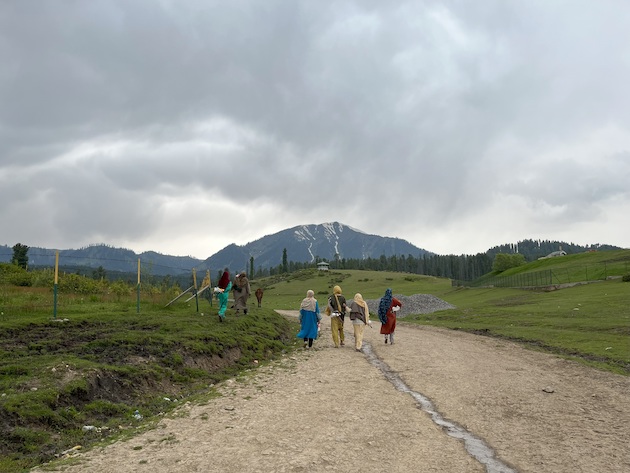BUDGAM, INDIA, Sep 13 (IPS) – It has been over a decade since 32-year-old Rafiqa (not her real name) was sold to a villager after being lured by the promise that she would be employed in the handicrafts industry of Indian-administered Kashmir.
But, instead of getting a job, she was sold to a Kashmiri man in central Kashmir’s Budgam district for a paltry sum of 50,000 Indian rupees (USD 605). Before the traffickers lured her, Rafiqa lived with her parents and three siblings in a poor Muslim family in West Bengal, a state in eastern India.
Ranging from Rohingya refugees – there are an estimated 40,000 Rohingya refugees in India – to women in other states of the country, such as West Bengal and Assam, women are trafficked and sold as brides to men who find it hard to find brides within their communities. Such grooms often include aged, physically challenged, and men with mental health issues.
Rafiqa’s husband, who drives a horse-cart for a living and lives in a one-room wooden shed, had to sell the only cow he possessed to pay the sum to the human traffickers.
She has now come to terms with “what I was destined to face in my life.” Embracing the reality, she says, was the only option left with her.
“I could have either tried to escape or taken some extreme step, but I decided to apply myself positively to make some kind of life out of what I ended up with,” Rafiqa told IPS while sitting at the base of the small wooden staircase of her house. “My husband’s simplicity and kind nature were also helpful in taking this decision – even though I didn’t like his appearance.”
“Now I have three kids for whom I have to live,” Rafiqa said. “I miss my parents and siblings. But it is very difficult to visit them. Even if I convince my husband, we can’t afford to visit them as it takes a lot of money to pay for the travel,” she added, saying her husband hardly provides two square meals for the family.
Rafiqa is not the only trafficked woman in that village. Over a dozen women have ended up getting married in similar circumstances. Elsewhere in the region, hundreds of other women from the Indian states of West Bengal and Assam are married to divorced and physically challenged men.
When 23-year-old Zarina (name changed), a woman from a poor family in West Bengal, got ensnared in a human trafficker’s trap, she had no idea that she would end up marrying a man whom she had never seen and was almost double her age. Zarina also fell for the false promise that a job in a carpet manufacturing unit in north Kashmir’s Patan area would be arranged for her. But, to her shock, she was sold into marriage.
“Now, how will my situation change after talking to you if it has not changed in the last five years? This is where I must be all my life,” an annoyed Zarina told IPS and then refused to elaborate.
Some women who encounter human traffickers are far unluckier. In a village of southern Kashmir’s Anantnag district, a young Rohingya woman was sold to a family by traffickers for their son with mental health issues after she was trafficked from a Rohingya refugee makeshift camp in the adjacent Jammu province.
“We were surprised when we discovered that the family has got a bride for their son who we knew was not mentally sound since his childhood,” said a neighbour of the family. “We would hear her screaming when her husband used to beat her almost every day. But fortunately for her, the young Rohingya woman was somehow able to escape after a few months.”
There are not any accurate official figures about sold brides, but some estimates say that thousands of girls and women are sold annually. The media sometimes reports the arrest of human traffickers, but such reports are not that common.
On July 26, India’s Minister of State for Home Affairs, Ajay Kumar Mishra, told the Indian parliament that 1,061,648 women above 18 years and 251,430 girls below 18 years went missing between 2019 and 2021 across different states in the country.
Mishra, however, said that most of the victims have been found and added that the Indian government has taken several initiatives for the safety of women.
Last year in April, India’s National Commission for Women launched an Anti-Human Trafficking Cell “to improve effectiveness in tackling cases of human trafficking, raising awareness among women and girls, capacity building and training of Anti Trafficking Units, and to increase the responsiveness of law enforcement agencies.”
In its 2023 Trafficking in Persons Report, the US Department of State identifies India as a Tier 2 country.
“The Government of India does not fully meet the minimum standards for the elimination of trafficking but is making significant efforts to do so. The government demonstrated overall increasing efforts compared with the previous reporting period, considering the impact of the COVID-19 pandemic, if any, on its anti-trafficking capacity; therefore, India remained on Tier 2,” the report says.
IPS UN Bureau Report
Follow @IPSNewsUNBureau
Follow IPS News UN Bureau on Instagram
© Inter Press Service (2023) — All Rights ReservedOriginal source: Inter Press Service
Check out our Latest News and Follow us at Facebook
Original Source

